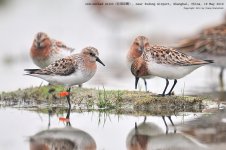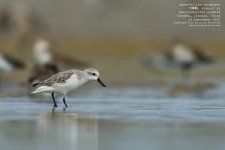"Àihù" (love-save) the Spooner
Much of the discussion in this thread is about the very important work of saving the spoon-billed sandpiper. My contribution is to help us celebrate the spoon-billed sandpiper. Saving and loving the bird are one and the same thing; Chinese in fact has a most appropriate word, 爱护 (àihù), often translated "cherish," combining the words for love and protect and often used in the context of conserving wildlife.
Here's the story behind the attached image: First, I distinguish the spooner in the flock of nearly 1,500 birds. I note its behavior; I see it swishing its spatulate bill through the water, quite unlike the manner of the superficially similar red-necked stint. Pleasure floods me: "It's a spooner!" My heart starts beating fast. Keep focused, I say to myself; don't try to do too much. I played baseball through high school, and the feeling with the spooner was very much like the feeling of coming to the plate in a tight game. Stay within yourself, my coaches used to say, but on the other hand, seize the moment! I check the settings on my camera; no blunders now! I zero in on the sandpiper. The bird knows I'm near, but it has bigger things on its mind than the strange but slow-moving object 12 m away; it needs to replenish itself; it needs to eat, eat, eat. When the spooner finally moves out of range, I don't pursue him; I've done enough, and there's pleasure in knowing that my huge harvest came at so little cost to the spooner.
so maybe a flag can give me kind of clue(I hope they dont do the same flags on Red-necked Stint)





